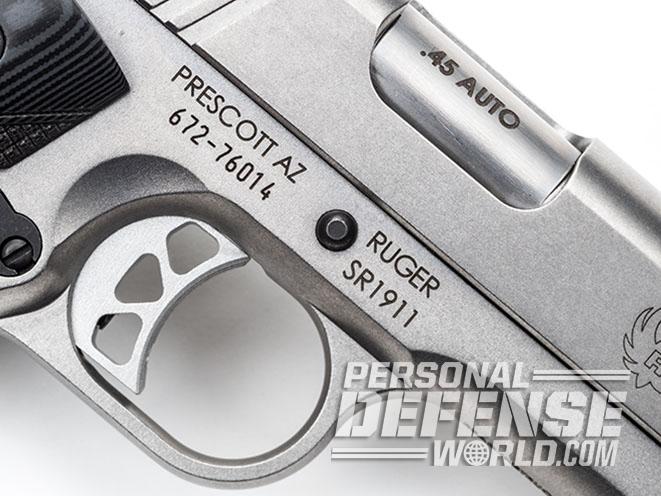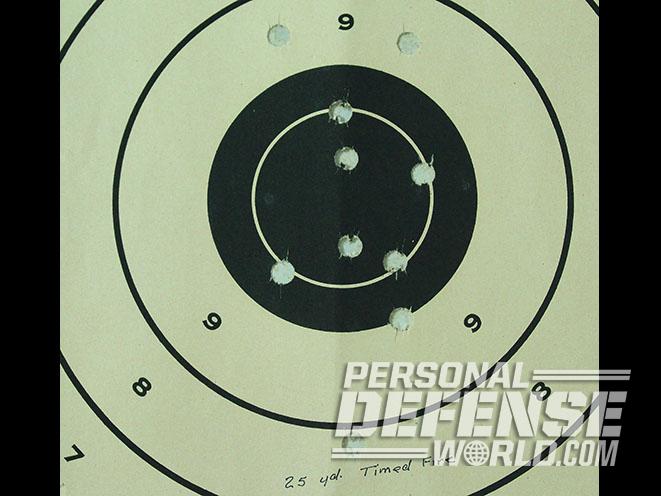When Sturm, Ruger & Company introduced the SR1911 in 2011, it quickly proved to be a very reliable, well-made and reasonably priced 1911-style pistol in .45 ACP. The public clearly liked it, and for a while it was very hard to get one. Within two years, Ruger introduced a Commander model and, more recently, a Lightweight Commander. Given its record of success, it’s no surprise that Ruger just introduced the new SR1911 Target model to round out its line of 1911s, and it’s a good one.
Zeroing In

As its name implies, the SR1911 Target is a classic target pistol. Like many other target 1911s, this SR1911 has a 5-inch barrel; a Series 70 firing mechanism; a long, skeletonized target trigger with an adjustable trigger stop; a BoMar-style adjustable rear sight; and a steel frame with dimensions that are very similar to many other full-sized 1911s.
On the other hand, the SR1911 Target also differs from the standard 1911 target pattern in several important ways. First, it has a matte stainless steel finish instead of a polished blued steel finish. In addition, it has deluxe checkered G10 grips instead of custom wood grips. It also has a Commander-style hammer, a full-strength recoil spring, a beavertail grip safety, a raised magazine release button, an ambidextrous thumb safety, a lowered and flared ejection port, a ramped front sight and a beveled magazine well. These features make the SR1911 Target as well suited to IDPA and IPSC matches as it is for shooting Bullseye competitions. Sadly, not that many people shoot in Bullseye matches anymore, and to sell well in today’s market, a target 1911 has to be usable for all types of competition, not just Bullseye.
Advertisement — Continue Reading Below
- RELATED STORY: Remastered Ruger LCP .380 – A Look at the LCP II
In addition, the SR1911 Target has features that are only found on Ruger 1911s. The Target model uses an ultra-light titanium firing pin to help prevent an unintended discharge if the pistol is dropped. In addition, if you’ve ever had a 1911 plunger tube take off for parts unknown (and I have), you’ll appreciate the SR1911 Target’s integral plunger tube, which cannot be separated from the pistol like the older-style staked tube can.
Another interesting element of the pistol’s design is the fact that the slide and bushing are machined from a single piece of bar stock. Ruger states that this enhances the pistol’s accuracy. It also has a swaged barrel link pin to help eliminate any play in the lower lockup as the barrel moves in and out of battery. This also helps the barrel return to the exact same position each time it cycles—another feature promoting inherent accuracy.
The Unboxing

It’s one thing to have a lot of nice features, but a target pistol must be made well to be both accurate and reliable. There are no do-overs in IDPA, and the last thing a Bullseye shooter wants to do is slow the line down shooting alibis. Have lots of alibis and you may soon find yourself being “invited” to call the line instead of shoot on a frequent basis.
Advertisement — Continue Reading Below
The first things I look for when I field-strip a gun for a bench evaluation are tool marks (especially in out-of-the-way places), scratches, spots or an uneven finish, roughness in the bore, an uneven crown on the barrel, a loose fit between internal parts, sharp edges and poorly conformed parts or lines. I found nothing inside or outside on the SR1911 Target indicating poor workmanship. On the other hand, if I used this gun for practical shooting, I would take a small file and round the ears on the rear sight, as they were a bit sharp for clearing stoppages rapidly.
I reassembled the pistol and examined its action to determine how well the slide fit the frame, to assess the weight and smoothness of the trigger pull, and to check the ease with which the sight adjusted. In addition, I assessed the smoothness with which the major controls operated, the fit and operation of the hammer and grip safety, and the fit of the magazines in the magazine well. Everything fit and worked very well. The slide movement was smooth, and there was only a barely perceptible amount of play between the rear of the slide and the frame. The trigger pull had some roughness and creep. On the other hand, the trigger consistently broke at 4.25 pounds. Overall, the trigger was decent but not as exacting as those in more expensive .45s.
Running The Ruger SR1911 Target

I bench-tested the SR1911 Target at the Big 3 East Training Center to measure its accuracy and velocities. I also used it to fire an Army “L” course during the weekly Bullseye match at the Flagler Gun & Archery Club. Four loads were chosen for testing: CCI’s 230-grain Blazer Brass FMJs, Freedom Munitions’ 230-grain Hush RN ammo, Black Hills’ 200-grain semi-wadcutters (SWCs) and, since the SR1911 Target has a standard 1911 recoil spring system and can also be used for personal defense, Sig Sauer’s 230-grain V-Crown JHPs. The pistol’s reliability was very good with the loads using JHP and RN bullets, but there were a couple of failures to feed with the Black Hills SWC load, which uses rather short, blunt, 200-grain projectiles.
Advertisement — Continue Reading Below
To test the pistol’s accuracy, I fired three 5-shot groups with each load at 25 yards. The bench testing indicated that the SR1911 Target tended to shoot tighter groups with the Black Hills and Freedom Munitions loads. Overall, groups fired from the bench were 3 to 5 inches in size. Some groups would have been smaller, but there was a tendency for an occasional flyer to open up the groups. I measured the velocities using a Competition Electronics ProChrono chronograph. The Black Hills ammo was the fastest load, and the most powerful was the Sig Sauer ammo, which left the barrel at 867 fps and generated 384 foot-pounds of energy at the muzzle.
- RELATED STORY: Patriotic Defender – Ruger’s American Compact Pro 9mm
I competed in the Army “L” match by running the SR1911 Target pistol through three stages with just my strong hand. The “Slow Fire” stage involved firing 10 shots at 25 yards in approximately five minutes. The “Timed Fire” stage, also fired at 25 yards, involved shooting two 5-round strings, each one in 15 seconds. The target was then moved up to 15 yards for the “Rapid Fire” stage, which also involved firing two 5-round strings, each one in 11 seconds. The total possible score was 300-30X. My total score was 283-13X, with the individual stages being very close in score: 93-4X for Slow Fire, 96-6X for Timed Fire and 94-3X for Rapid Fire.
This test clearly demonstrated that the SR1911 Target could be fired accurately, quickly and consistently under stress, which is the intended use of a target pistol. Finally, I did a little informal shooting at steel plates. The pistol proved capable of consistently hitting steel out to 25 yards.
Advertisement — Continue Reading Below
The Ruger SR1911 Target is clearly a well-made pistol that performed well for me in Bullseye competition. Even better, its $1,019 price tag is quite reasonable for all the features that this pistol offers.





































